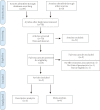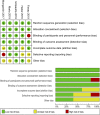Efficacy of Probiotics as Adjunctive Therapy to Nonsurgical Treatment of Peri-Implant Mucositis: A Systematic Review and Meta-Analysis
- PMID: 33536901
- PMCID: PMC7847846
- DOI: 10.3389/fphar.2020.541752
Efficacy of Probiotics as Adjunctive Therapy to Nonsurgical Treatment of Peri-Implant Mucositis: A Systematic Review and Meta-Analysis
Abstract
Background: Peri-implant mucositis (PiM) is an inflammation of the soft tissues surrounding the dental implant and is the precursor of the destructive inflammatory peri-implantitis. PiM is usually reversible, but difficult to eradicate. Mechanical debridement (MD) is the conventional procedure to treat PiM although not enough to reach a complete resolution. Recently, probiotics have been considered in the treatment of peri-implant disease. Therefore, the aim of this systematic review and meta-analysis was to investigate the efficacy of the probiotic therapy combined with MD compared with MD alone or MD + placebo in patients with PiM. Methods: A search using electronic databases (MEDLINE, Science Direct databases, and Cochrane Central Register of Controlled Trials) and a manual search were performed up to November 2019 by two reviewers independently of each other. Eligible randomized controlled trials (RCTs) comparing MD + probiotic vs. MD were included. The quality assessment for all the selected RCTs was conducted according to the Cochrane Handbook for Systematic Reviews of Interventions. Probing depth reduction was selected as the primary outcome. Weighted mean difference (WMD) and 95% confidence interval (CI) were calculated for continuous outcomes, and odds ratio (OR) and 95% CI were calculated for dichotomous outcomes, using random effect models. This review was registered on the PROSPERO database (CRD42020213625). Results: Five eligible publications were included in this systematic review and four in the meta-analysis. As regards the implant, the WMD in the probing depth reduction between the test and control group was -0.12 mm [95% CI (-0.38, 0.14), p = 0.38], meaning that the adjunctive probiotic therapy was not improving PiM compared with MD alone or MD + placebo. The meta-analysis also showed no statistically significant results in the secondary outcomes (reduction of full mouth plaque index and full mouth bleeding on probing, absence of bleeding on probing at implant level, and changes in microorganism load and species). Conclusion: The findings of this systematic review and meta-analysis suggested that the additional use of probiotics did not improve the efficacy of MD in PiM treatment regarding clinical and microbial outcomes, at least in a short-term.
Keywords: adjunctive treatment; nonsurgical treatment; peri-implant mucositis; probiotic; systematic review.
Copyright © 2021 Zhao, Hu, Wang, Lai and Jian.
Conflict of interest statement
This study was supported by grants from the Science and Technology Department of Sichuan Province (No. 2018SZ0232). The authors declare that the research was conducted in the absence of any commercial or financial relationships that could be construed as a potential conflict of interest.
Figures





Similar articles
-
Adjunctive Use of Active Compounds such as Chlorhexidine in the Nonsurgical Treatment of Peri-Implant Mucositis for Oral Health: A Systematic Review and Meta-Analysis.Oxid Med Cell Longev. 2022 Aug 27;2022:2312784. doi: 10.1155/2022/2312784. eCollection 2022. Oxid Med Cell Longev. 2022. PMID: 36065438 Free PMC article.
-
Does Probiotic Lactobacillus Have an Adjunctive Effect in the Nonsurgical Treatment of Peri-Implant Diseases? A Systematic Review and Meta-analysis.J Evid Based Dent Pract. 2020 Mar;20(1):101398. doi: 10.1016/j.jebdp.2020.101398. Epub 2020 Jan 29. J Evid Based Dent Pract. 2020. PMID: 32381407
-
Efficacy of mechanical debridement with adjunctive probiotic therapy in the treatment of peri-implant mucositis in cigarette-smokers and never-smokers.Clin Implant Dent Relat Res. 2019 Aug;21(4):734-740. doi: 10.1111/cid.12795. Epub 2019 May 16. Clin Implant Dent Relat Res. 2019. PMID: 31094086
-
Clinical and Radiographic Outcomes of Adjunctive Photodynamic Therapy for Treating Peri-Implant Mucositis Among Cigarette Smokers and Diabetics: A Systematic Review and Meta-Analysis.Photobiomodul Photomed Laser Surg. 2023 Aug;41(8):378-388. doi: 10.1089/photob.2023.0046. Epub 2023 Jul 28. Photobiomodul Photomed Laser Surg. 2023. PMID: 37506360 Review.
-
Adjunctive benefit of probiotic supplementation along with nonsurgical therapy for peri-implant diseases - A systematic review and meta-analysis.J Indian Soc Periodontol. 2023 Jul-Aug;27(4):352-361. doi: 10.4103/jisp.jisp_308_22. Epub 2023 Jul 1. J Indian Soc Periodontol. 2023. PMID: 37593565 Free PMC article. Review.
Cited by
-
Probiotics in Periodontal and Peri-Implant Health Management: Biofilm Control, Dysbiosis Reversal, and Host Modulation.Microorganisms. 2022 Nov 18;10(11):2289. doi: 10.3390/microorganisms10112289. Microorganisms. 2022. PMID: 36422359 Free PMC article. Review.
-
Smoking by altering the peri-implant microbial community structure compromises the responsiveness to treatment.Front Cell Infect Microbiol. 2022 Oct 14;12:1040765. doi: 10.3389/fcimb.2022.1040765. eCollection 2022. Front Cell Infect Microbiol. 2022. PMID: 36310860 Free PMC article.
-
The Integration of Advanced Drug Delivery Systems into Conventional Adjuvant Therapies for Peri-Implantitis Treatment.Pharmaceutics. 2024 Jun 5;16(6):769. doi: 10.3390/pharmaceutics16060769. Pharmaceutics. 2024. PMID: 38931890 Free PMC article. Review.
-
Probiotics in the Treatment of Radiotherapy-Induced Oral Mucositis: Systematic Review with Meta-Analysis.Pharmaceuticals (Basel). 2023 Apr 27;16(5):654. doi: 10.3390/ph16050654. Pharmaceuticals (Basel). 2023. PMID: 37242437 Free PMC article. Review.
-
The Potential Value of Probiotics after Dental Implant Placement.Microorganisms. 2023 Jul 20;11(7):1845. doi: 10.3390/microorganisms11071845. Microorganisms. 2023. PMID: 37513016 Free PMC article. Review.
References
-
- Augthun M., Conrads G. (1997). Microbial findings of deep peri-implant bone defects. Int. J. Oral Maxillofac. Implants 12, 106–112. - PubMed
-
- Cochrane Collaboration (2019). Cochrane handbook for systematic reviews of interventions version 5.1.0. London, United Kingdom:Cochrane Collaboration.
Publication types
LinkOut - more resources
Full Text Sources
Other Literature Sources
Research Materials

